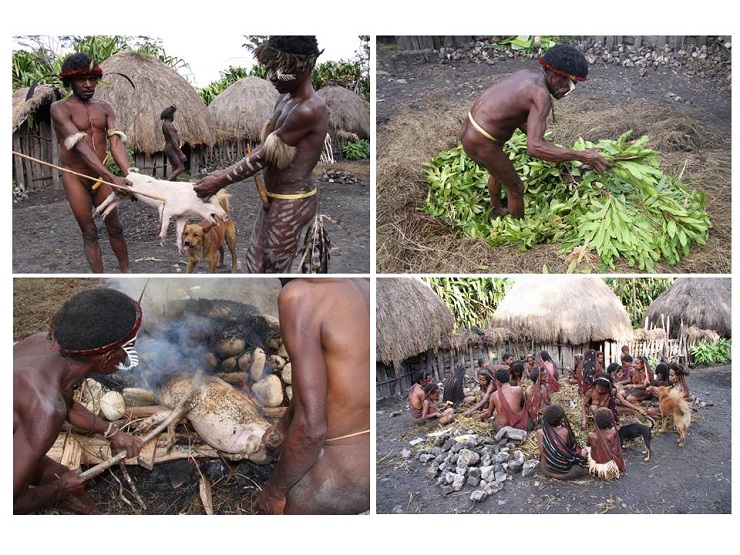Shared eating and drinking represent a long-term anthropological constant, ranging from the culturally remote environment of “the others” to the modern world of global civilisation.
Feasts always represented and still represent a specific form of social interaction, for which a special term – commensal – is used. This concept defines the basis of those relationships that arise and is related to the metaphorical sharing of a communal table during meals. They may represent a means of achieving a wide range of social objectives, such as marriages, building alliances, mobilising a workforce, demonstrating power, redistributing property, celebrating rites of passage and other purposes. In our society, for example, funeral receptions have survived as a tool for uniting the survivors and helping them to deal with their sadness.
 |
| Some specific artefacts were also used at feasts, such as the wooden bowl decorated with engravings for the sago pudding. Asam, Madang, Papua New Guinea. Photo by Jan Rendek. |
Feasts in archaic societies were inextricably linked with the rituals and the symbolic representation of social relations. Not only food constituted part of the celebration, but also alcoholic beverages produced by the fermentation of different crops. For the production of these beverages it would have been necessary to sacrifice some (frequently substantial) part of the harvest. In addition to feasting there were receptions, the main function of which was the legitimisation and the confirmation of positions of power. An example can be the habits that have become customary in the Highlands of New Guinea. The self-presentation banquets, organised by the big man, had a competitive character. By organising these banquets he confirmed his social position.
Such societies also encompass the Enga population (cca. 200,000 people), which grow mainly sweet potatoes in intensively cultivated gardens. Polly Wisner, the anthropologist, when she was studying local rituals, suggested categorising these feasts in two basic types - i.e. sacred or secular feasts. Most of the secular feasts were directly linked to multi-phase exchange cycles, the phases of which might be separated by weeks, months or even years. They involved the distribution of pigs and of other commodities. Exchanges that placed an emphasis on the distribution of pork were of a very competitive nature, with the objective of giving more rather than receiving and thereby increasing the participants’ social status. This applied not only to the actual big men, but to all of the male members of the local agricultural population. In addition, secular feasts were also organised within the family on such occasions as a) the mobilisation of labour for the purpose of the planning and the implementation of major work activities, b) weddings, c) as a specific manner of thanking mothers for their bringing-up of a child, or as a means of compensation for his or her injury, d) funeral feasts conceived as providing compensation to the maternal kinship line for the loss of a member who has left them behind.
|
|
| The street sale of beer in Burkina Faso. Photo by Eliška Podgorná, 2015. |
 |
| Hog killing together with a smaller feast inside one of the houses in the Highlands of New Guinea. The pig was killed by an arrow that was shot at close range. After it has been gutted, the entire pig is placed in a pit that is lined with grass and leaves, on which a pile of hot stones is then laid. Photo by J. Rendek, 2008. |
Want to learn more?
- Dietler, M. 2001. Theorizing the Feast: Rituals of Consumption, Commensal Politics, and Power In African Contexts. In Feasts. Archaeological and ethnographic perspectives on food, politics, and power, eds. M. Dietler, and B. Hayden, 65-114. Washington and London: Smithsonian Institution Press.
- van Genep, A. 1997. Přechodové rituály. Praha: Nakladatelství Lidové noviny. (1909, Les rites de passage, étude systematique des rites. Émile Nourry. Paris).
- Wiessner, P. 2001. Of feasting and value: Enga feasts in a historical perspective (Papua New Guinea). In Feasts: Archaeological and ethnographic Perspectives in Food, Politics and Power, eds. M. Dietler, and B. Hayden, 115-143. Washington: Smithsonian Institution Press.
 Archeologické 3D virtuální muzeum
Archeologické 3D virtuální muzeum

.jpg)
